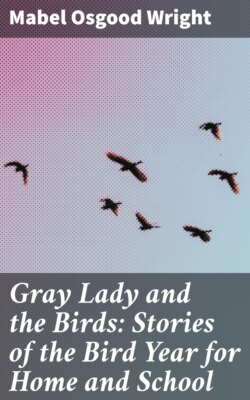Читать книгу Gray Lady and the Birds: Stories of the Bird Year for Home and School - Mabel Osgood Wright - Страница 8
На сайте Литреса книга снята с продажи.
The Bird Year and the Migration
ОглавлениеTable of Contents
“People who think of birds at all know that they are not equally plentiful at all times of the year, but that they have their seasons of coming and disappearing, as the flowers have, though not for exactly the same reason.
“We are accustomed to see the plants send up shoots through the bare ground every spring, unfold their leaves and blossoms, and, finally, after perfecting seed, wither away again at the touch of frost.
“Of these plants, as well as some large trees, a few are more hardy than others, like the ground-pine, laurel, and wintergreen, and are able to hold their leaves through very cold weather, and we call them evergreens.
“You notice that the birds appear in spring even before the pussy-willows bud out, and that every morning when you wake, the music outside the window and down among the alders on the meadow border is growing louder, until by the time the apple trees are in bloom there seems to be a bird for every tree, bush, and tuft of sedgegrass.
“By the time the timothy is cut and rye harvested, you do not hear so great a variety of song. The Robin, Song Sparrow, House Wren, and Meadowlark are still in good voice, and an occasional Catbird, but the Bobolink has dropped out, and the Brown Thrasher no longer tells the farmer how to plant his corn: ‘Drop it, drop it, cover it up, hoe it, hoe it;’ and very wise he is, too, for the corn is all planted.
“Later still, when the stacked cornstalks fill the fields with their wigwams, like Indian encampments, the pumpkins are gathered in golden heaps, and the smoke of burning leaves and brush pervades the air, you hear very few bird songs, for many birds have either dropped silently out of sight or collected in huge flocks, like the Swallow, swept by, and disappeared in the clouds, while others, like the Purple Grackle or Common Crow-Blackbird,—walk over the stubble and cover the trees, making such a creaking, crackling noise that one would surely think that their wings as well as voices were rusty and needed oiling.
“What has become of the birds? Where do they go when they disappear?
“Being warm-blooded animals they cannot dive into the mud and hide, like fishes, or crawl into cracks of tree bark and wrap themselves up in cocoons, like insects. Neither do they drop their feathers and die away as tender plants drop their leaves and disappear.
“People once believed that Swallows dived through the water into the mud, where they rolled themselves into balls and slept all winter. They thought this because Swallows are seen in early autumn in flocks about ponds and marshes, where they feed upon the insects that abound in such places. People thought that as Swallows were last seen in these places before they disappeared they must have gone under the water; but this was merely guessing, which is a very dangerous thing to do when trying to find out the plans that Nature makes for her great family.
“Later yet, when the snow begins to fall, there is little or no bird music, only the hoot of an Owl, the shrill cry of the Hawks, the ‘quank, quank’ of the Nuthatch, that runs up and down the tree-trunks like a mouse in gray-and-white feathers, the jeer of the Jay, and the soft voice of the Chickadee that, as you have just heard, tells you his name so prettily as he peers at you from beneath his little black cap.
“But the Catbird, Wren, Bobolink, Oriole, the Cuckoo that helped clear the tent caterpillars from the orchard, the Chat that puzzled the dogs by whistling like their master, the beautiful Barn Swallow, with the swift wings, that had his plaster nest in the hayloft, the Phœbe that built in the cowshed, and the dainty Humming-bird that haunted the honeysuckle on the porch and hummed an ancient spinning-song to us with his wings,—where are they all?
“And why is it that while those have disappeared, some few birds still remain with us in spite of cold and snow?”
